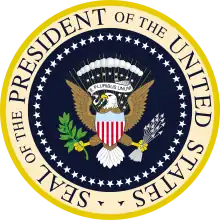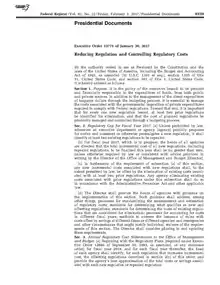Executive Order 13771
Executive Order 13771 —entitled "Reducing Regulation and Controlling Regulatory Costs"— is an executive order signed by U.S. President Donald Trump on January 30, 2017.[1] It directs agencies to repeal two existing regulations for every new regulation, and to do so in such a way that the total cost of regulations does not increase. It is an example of a PAYGO (Pay As You GO) policy for regulations, comparable to regulatory PAYGO policies in Canada, the United Kingdom and Australia.[2]
| Reducing Regulation and Controlling Regulatory Costs | |
 | |
 Executive Order 13771 in the Federal Register | |
| Type | Executive order |
|---|---|
| Executive Order number | 13771 |
| Signed by | Donald Trump on January 30, 2017 |
| Federal Register details | |
| Federal Register document number | 2017-02451 |
| Publication date | February 3, 2017 |
| Document citation | 82 FR 9339 |
| Summary | |
Directs agencies to:
| |
On January 20, 2021, U.S. President Joe Biden revoked the order with a presidential action.[3]
Provisions
Executive Order 13771 requires any executive department or agency who plans to publicly announce a new regulation to propose at least two regulations which will in turn be repealed. The cost of the implementation of these new regulations must be less than or equal to 0 dollars. If costs above 0 dollars are accrued, the payment of these costs shall be funded through the elimination of more regulations. Advice on the financial aspect of these matters is provided by the director of the Office of Management and Budget.[4]
Director of the Office of Management and Budget
It is up to the director to notify agencies of their total incremental costs for a given year. The director is allowed to issue both increases or decreases in said costs. The director also has the authority to exempt regulations/agencies from compliance with the Executive Order.[4]
Implications
The practical effects of Executive Order 13771 are uncertain. Previous attempts to limit regulation over the past several decades have had little impact.[5] The order states, "it is essential to manage the costs associated with the governmental imposition of private expenditures required to comply with Federal regulations."[4]
Lawsuit
On February 8, 2017, Public Citizen, Natural Resources Defense Council, and Communications Workers of America filed a lawsuit against the implementation of the Executive Order 13771. The lawsuit states that the passing of the Executive Order by the Trump Administration is unconstitutional by violating separation of powers and overstepping the authority allowed under the Take Care Clause. This would make federal agencies violate governing statutes, like the Administrative Procedure Act which establishes the way agencies pass regulations.[6] By forcing federal agencies to focus on costs rather than benefits, these groups argue that the Executive Order harms the public by forcing agencies to repeal beneficial regulations and arbitrarily preventing new regulations to be passed.[7]
The plaintiffs claim that Executive Order 13771 will endanger public health, safety, and the environment and will force federal agencies to violate current governing statutes by ignoring the non-financial benefits current and potential regulations bring to the public.[6] In particular, the lawsuit cites several regulations that will be adversely affected, including:
- Motor Vehicle Safety and Motor Carrier Safety Act
- Occupational Safety and Health Act
- Mine Safety and Health Act
- Toxic Substance Control Act
- Hazardous Materials Transportation Act
- Federal Railroad Safety Act
- Federal Water Pollution Control Act
- Energy Policy and Conservation Act
- Endangered Species Act
- Clean Air Act
Response and ruling
On April 10, 2017, the White House responded with a court filing, asking to dismiss the lawsuit due to its speculative nature. Because no regulations have yet been directly affected, the administration claims the lawsuit is premature. In addition, the administration claims that the Executive Order does not exceed the president's scope of power.[8]
On February 26, 2018, DC District Court granted the White House's motion to dismiss the case, holding that Public Citizen, NRDC, and CWA had failed to establish that they had standing to bring the case.[9]
Revival
The District Court set a deadline of April 2, 2018, for the plaintiffs to file a motion for leave to amend the complaint, to try to satisfy the concerns stated in the order granting the motion to dismiss. The plaintiffs filed a motion for leave to file a second amended complaint, accompanied by ten additional declarations, to show their standing to pursue the case. The government did not oppose the motion, which was then granted. The parties will now brief dispositive motions.[10]
Reception
Former Obama-era FTC chairman and Public Citizen Litigation Group lawyer David Vladeck called the executive order "unconstitutional, illegal and stupid," saying "if you really want to reduce the regulatory load, you can't use a shotgun, you have to use a scalpel."[11]
On April 17, 2017, fourteen states (West Virginia, Wisconsin, Alabama, Arizona, Arkansas, Georgia, Kansas, Louisiana, Michigan, Nevada, Oklahoma, South Carolina, Texas, and Wyoming) filed an amici curiae in support of the Executive Order.[12] The Republican states argue that the Executive Order falls within allowed presidential authority and will benefit state governments.[13]
Effects
In March 2017, the US Patent and Trademark Office (USPTO) formed a "Working Group On Regulatory Reform" to implement Executive Order 13771 to review and improve USPTO regulations.[14]
According to The Weekly Standard's Peter J. Boyer, writing in October 2017, the effect of the order "has been to greatly delay new regulations": "The government has added an average of 13,000 new restrictions annually for the past 20 years. Under Trump, the number of new regulations is near zero."[15]
References
- "Presidential Executive Order on Reducing Regulation and Controlling Regulatory Costs". whitehouse.gov. January 30, 2017. Retrieved January 21, 2021.
- Peacock, Marcus (December 7, 2016), "Implementing a Two-for-One Regulatory Requirement in the U.S." (PDF), The George Washington University Regulatory Studies Center
- "Executive Order on Revocation of Certain Executive Orders Concerning Federal Regulation". whitehouse.gov. January 20, 2021. Retrieved January 21, 2021.
- "Reducing Regulation and Controlling Regulatory Costs". Federal Register. February 3, 2017. Retrieved March 10, 2017.
- "President Trump Issues Executive Order Aimed at Reducing Regulation and Controlling Regulatory Costs". The National Law Review. Retrieved March 15, 2017.
- "PC, NRDC, CWA v. Donald J. Trump" (PDF). Archived from the original (PDF) on February 15, 2017. Retrieved March 18, 2017.
- "Background on 2 for 1 Lawsuit" (PDF). NRDC.
- Henry, Devin (April 11, 2017). "White House asks court to dismiss suit over regulation repeals". The Hill.
- Memorandum Opinion and Order , Civil Action No. 17-253 (RDM), United States District Court for the District of Columbia .
- "Public Citizen, NRDC, and CWA v. Donald Trump, et al. - Public Citizen". www.citizen.org.
- Gerstein, Josh (April 10, 2017). "How Merrick Garland could torment Trump". Politico.
- Devaney, Tim (April 18, 2017). "Trump's 'One In, Two Out' Regulatory Policy Backed by 14 States". The Hill.
- "Brief of Amici Curiae the States of West Virginia, Wisconsin, and 12 Other States" (PDF).
- "USPTO Working Group on Regulatory Reform". www.uspto.gov. Office of the Chief Communications.
- Boyer, Peter J. (October 30, 2017). "Donald Trump: King of Deregulation?". The Weekly Standard. Retrieved October 25, 2017.
External links
| Wikisource has original text related to this article: |